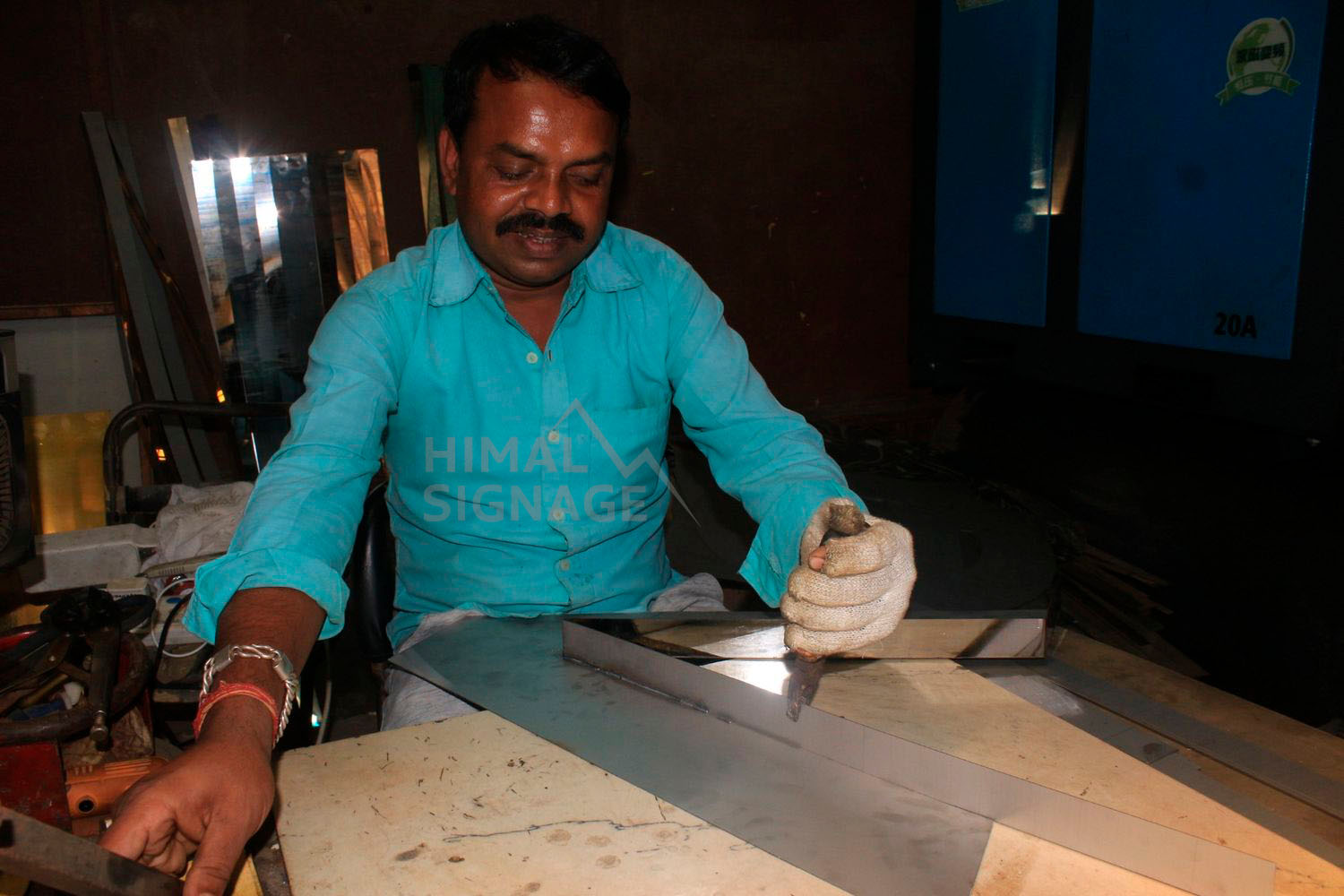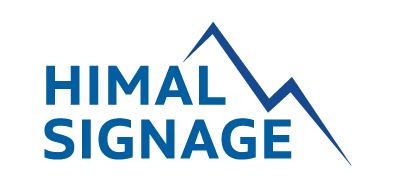
Most people don’t notice it, but metal is quietly holding half your world together. That gate you walked past, that sign above your favorite coffee shop, even the stairs you climb every day they all have one thing in common… They started as plain, flat steel and were transformed into something strong and useful through proper metal cutting and welding. So, how does raw steel turn into high-quality metal designs? In this blog, we’ll walk you through the real-world process behind metal cutting and welding in Nepal, and how Himal Signage brings it all together to turn raw material into solid, functional designs.
Table of Contents
What Is Metal Cutting?
Before you can build anything with metal, you have to cut it. And while it might sound simple, it takes skill, precision, and the right machines to get it right. So, here are some common metal cutting techniques widely used in Nepal:
Laser Cutting:
This is a method where a high-powered laser beam does the slicing. It’s super precise and great for fancy signs, detailed logos, or anything with a bit of style.
Plasma Cutting:
This one uses a special tool that blows out really hot air, hot enough to melt metal. It’s great for cutting thick sheets, like the kind used in building frames or heavy-duty gates.
Gas/Flame Cutting:
This one uses a mix of oxygen and fuel gas, making the flame hot enough to cut metal. It’s simple, strong, and perfect for big, basic cuts that need to get done fast.
Mechanical Cutting:
This uses tools like metal saws or big cutters to slice through metal by hand or with simple machines. Good old-fashioned blades still get the job done, especially for small projects or quick fixes, without anything fancy.
So, whether it’s a shop sign, a gate, or a frame for a staircase, it usually starts with a clean cut to get the metal ready for what comes next.
At Himal Signage, we provide precise cutting solutions to turn raw metal into clean, custom designs. Here’s what we offer:
- CNC Cutting – For sign boards, jali designs, 3D letters, and Custom branding work.
- Laser Cutting – For decorative wall panels and artistic signage
- Plasma Cutting – For industrial signage and bold, functional designs.
No matter the project, we make sure every cut is clean, accurate, and ready for what comes next.
What Is Welding?
Cutting gives you the pieces. Welding brings them together. Welding is how you fuse two or more pieces of metal using high heat. Once cooled, the pieces form a solid, strong bond that can hold up almost anything.
MIG Welding:
This method uses a wire that melts and joins metal pieces together. It’s fast, clean, and great for things like gates, frames, and signs.
TIG Welding:
This method uses a special needle-like tool, called a tungsten electrode, to create heat, and the welder controls it by hand (kind of like drawing with fire). It is slower but gives a very neat and polished finish.
Stick Welding:
This method uses metal rods to weld thick or heavy pieces together. It’s strong and works well for outdoor jobs like railings or support beams.
From shopfronts in Kathmandu to stair railings in Lalitpur, welding in Nepal plays a quiet but crucial role in the strength and safety of our surroundings.
At Himal Signage, we offer custom welding services designed to bring durability, design, and detail together. Here’s how we help:
- Brass Welding – For stylish 3D brass letters, logos, and decorative signs that look premium and last long.
- Logo Welding – To create strong, weather-resistant brand signs using high-quality brass or metal alloys.
- Decorative Metal Welding – For interior and exterior panels, nameplates, and custom features that add elegance to homes, shops, and hotels.
- Outdoor Signage Welding – Built to handle Nepal’s changing weather while still looking sharp in high-traffic areas.
Each weld is handled by trained professionals using modern tools, ensuring it’s clean, strong, and built to last.
Metals We Commonly Use in Welding and Metal Cutting Projects
In Nepal, some metals show up more often than others, depending on the project:
- Mild Steel: Tough and affordable, a go-to for gates, frames, and building elements.
- Aluminum: Lightweight and rust-free. Used for modern designs, signs, and windows.
- Stainless Steel: Strong, shiny, and durable. Perfect for stylish structures.
- Brass/Copper: More decorative. Adds a premium touch to signs and displays.
Choosing the right metal is a key part of metal cutting in Nepal and welding in Nepal, depending on where it’s going and how it will be used.
At Himal Signage, we help you choose the right metal for your project, too. Whether it’s for strength, style, or weather resistance, our team will guide you to what works best.
Behind the Scenes: How the Process Works
Most people only see the final result; the gate, the sign, the railing. But what actually happens before all that?
Here’s a look behind the scenes:
at Himal Signage, we turn raw steel into high-quality designs using our professional cutting and welding services.
Step 1: Planning & Designing
Everything starts with an idea. Maybe it’s a shop sign, a metal gate, or a cool-looking staircase railing.
First, the team asks a few important questions:
- Is it for indoors or outdoors?
- Should it be strong, stylish, or both?
- What metal works best - steel, aluminum, maybe even copper?
Then, they sketch out a plan. Think of it like drawing the blueprint before building a LEGO set, but with metal, sparks, and a bit more heat.
Step 2: Cutting the Metal
Once the design is ready, it’s time to bring out the big tools. This is where the cutting happens. The team carefully measures and marks the metal, then uses machines, like lasers or flame cutters, to slice it into the perfect shape. Whether they’re making a nameplate or a heavy steel frame, this is where the real building starts.
Step 3: Welding & Assembly
Now it’s time to put the pieces together. This part is like solving a puzzle, but with heat. The metal parts are lined up, clamped down, and welded piece by piece. Welding makes the whole thing strong enough to hold weight, handle weather, and last for years. If it’s something decorative, they take extra care to keep it looking smooth and sharp, because no one wants a wobbly-looking shop sign.
Step 4: Finishing Touches
Once everything is joined, it’s not quite ready yet, it needs that final polish. The team smooths out any rough edges, adds paint or coating to keep it from rusting, and gives it a last check to make sure it’s strong and safe. By the end, you’d never guess it started as a plain metal sheet, now it’s something built to last and made to impress.
Where You See Metal Cutting and Welding in Nepal
You might not notice it, but metal cutting and welding are everywhere in Nepal:
- Home gates and railings
- Shop signage and decorative nameplates
- Café decor and restaurant partitions
- Hotel lobby signs and room number plates
- Food stalls, benches, racks, and display shelves
Metal cutting reflects pride, creativity, and detail in everyday design. Likewise, welding helps create structures that are not only strong but beautifully made.
Who We Help
Whether you’re a business owner, a builder, a furniture maker, or someone with an idea on paper, Himal Signage can help you bring it to life. From metal signs to interior partitions, our services in welding in Nepal and metal cutting in Nepal cover projects big and small, creative and functional. Since 2010, we’ve worked on 1,000+ projects across Kathmandu, Lalitpur, and beyond combining clean design, solid construction, and clear communication. So whether you need a stylish sign, a solid frame, or a fully custom structure, we’re here to help.
Got a Project in Mind?
We’re local. We’re experienced. And we know how to turn raw ideas into real results.
Reach out to Himal Signage for:
- Metal cutting and welding in Nepal
- CNC design and fabrication
- Signage, panels, and custom interiors
Let’s build something bold, clean, and built to last.
Click here to contact us or visit us in Jwagal, Kupondole, Lalitpur.
